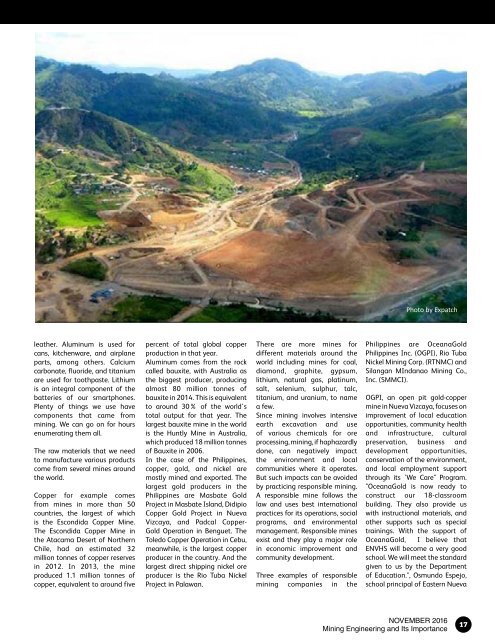GineersNow Engineering Magazine November 2016 Issue No 009
GineersNow Engineering Magazine November 2016 Issue No 009 Caterpillar Inc: A look at the company's social impact. Exclusive interview with Jean Savace, Vice President and Chief Technology Officer of Caterpillar Inc. Exclusive: Mining industry, social good, philanthropy, CSR, social impact, social innovation. Special Feature Stories: HVACR, Oil & Gas, Construction, Heavy Equipment, Machinery, Tools, Civil Engineering, Mechanical, Electrical, Plumbing, MEP, Water, Wastewater, Renewables, Energy, Petroleum, Heavy Equipment, Rental Equipment, Contractors, EPC. Country Focus: United States, Canada, United Arab Emirates, Saudi Arabia, Qatar, Bahrain, Kuwait, Oman, United Kingdom, Singapore, Hong Kong, Philippines, Malaysia, Indonesia, India, Australia More engineering stories at https://www.gineersnow.com/topics/magazines
GineersNow Engineering Magazine November 2016 Issue No 009
Caterpillar Inc: A look at the company's social impact. Exclusive interview with Jean Savace, Vice President and Chief Technology Officer of Caterpillar Inc.
Exclusive: Mining industry, social good, philanthropy, CSR, social impact, social innovation.
Special Feature Stories: HVACR, Oil & Gas, Construction, Heavy Equipment, Machinery, Tools, Civil Engineering, Mechanical, Electrical, Plumbing, MEP, Water, Wastewater, Renewables, Energy, Petroleum, Heavy Equipment, Rental Equipment, Contractors, EPC.
Country Focus: United States, Canada, United Arab Emirates, Saudi Arabia, Qatar, Bahrain, Kuwait, Oman, United Kingdom, Singapore, Hong Kong, Philippines, Malaysia, Indonesia, India, Australia
More engineering stories at https://www.gineersnow.com/topics/magazines
Create successful ePaper yourself
Turn your PDF publications into a flip-book with our unique Google optimized e-Paper software.
Photo by Expatch<br />
leather. Aluminum is used for<br />
cans, kitchenware, and airplane<br />
parts, among others. Calcium<br />
carbonate, fluoride, and titanium<br />
are used for toothpaste. Lithium<br />
is an integral component of the<br />
batteries of our smartphones.<br />
Plenty of things we use have<br />
components that came from<br />
mining. We can go on for hours<br />
enumerating them all.<br />
The raw materials that we need<br />
to manufacture various products<br />
come from several mines around<br />
the world.<br />
Copper for example comes<br />
from mines in more than 50<br />
countries, the largest of which<br />
is the Escondida Copper Mine.<br />
The Escondida Copper Mine in<br />
the Atacama Desert of <strong>No</strong>rthern<br />
Chile, had an estimated 32<br />
million tonnes of copper reserves<br />
in 2012. In 2013, the mine<br />
produced 1.1 million tonnes of<br />
copper, equivalent to around five<br />
percent of total global copper<br />
production in that year.<br />
Aluminum comes from the rock<br />
called bauxite, with Australia as<br />
the biggest producer, producing<br />
almost 80 million tonnes of<br />
bauxite in 2014. This is equivalent<br />
to around 30% of the world's<br />
total output for that year. The<br />
largest bauxite mine in the world<br />
is the Huntly Mine in Australia,<br />
which produced 18 million tonnes<br />
of Bauxite in 2006.<br />
In the case of the Philippines,<br />
copper, gold, and nickel are<br />
mostly mined and exported. The<br />
largest gold producers in the<br />
Philippines are Masbate Gold<br />
Project in Masbate Island, Didipio<br />
Copper Gold Project in Nueva<br />
Vizcaya, and Padcal Copper-<br />
Gold Operation in Benguet. The<br />
Toledo Copper Operation in Cebu,<br />
meanwhile, is the largest copper<br />
producer in the country. And the<br />
largest direct shipping nickel ore<br />
producer is the Rio Tuba Nickel<br />
Project in Palawan.<br />
There are more mines for<br />
different materials around the<br />
world including mines for coal,<br />
diamond, graphite, gypsum,<br />
lithium, natural gas, platinum,<br />
salt, selenium, sulphur, talc,<br />
titanium, and uranium, to name<br />
a few.<br />
Since mining involves intensive<br />
earth excavation and use<br />
of various chemicals for ore<br />
processing, mining, if haphazardly<br />
done, can negatively impact<br />
the environment and local<br />
communities where it operates.<br />
But such impacts can be avoided<br />
by practicing responsible mining.<br />
A responsible mine follows the<br />
law and uses best international<br />
practices for its operations, social<br />
programs, and environmental<br />
management. Responsible mines<br />
exist and they play a major role<br />
in economic improvement and<br />
community development.<br />
Three examples of responsible<br />
mining companies in the<br />
Philippines are OceanaGold<br />
Philippines Inc. (OGPI), Rio Tuba<br />
Nickel Mining Corp. (RTNMC) and<br />
Silangan MIndanao Mining Co.,<br />
Inc. (SMMCI).<br />
OGPI, an open pit gold-copper<br />
mine in Nueva Vizcaya, focuses on<br />
improvement of local education<br />
opportunities, community health<br />
and infrastructure, cultural<br />
preservation, business and<br />
development opportunities,<br />
conservation of the environment,<br />
and local employment support<br />
through its 'We Care" Program.<br />
"OceanaGold is now ready to<br />
construct our 18-classroom<br />
building. They also provide us<br />
with instructional materials, and<br />
other supports such as special<br />
trainings. With the support of<br />
OceanaGold, I believe that<br />
ENVHS will become a very good<br />
school. We will meet the standard<br />
given to us by the Department<br />
of Education.", Osmundo Espejo,<br />
school principal of Eastern Nueva<br />
NOVEMBER <strong>2016</strong><br />
Mining <strong>Engineering</strong> and Its Importance<br />
17


















